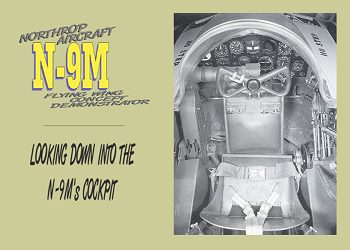
 |
The aircraft, constructed primarily of wood, had a wingspan of 60 feet and weighed 7,000 pounds. It was designed for an endurance of 3.2 hours with 100 gallons of fuel, and had a design ceiling of 21,500 feet. Rather than a control stick, the N-9M-1 had a control column and wheel. This cumbersome arrangement was consistent with its role as a bomber mock-up. Flight controls consisted of elevons, rudders, and trim tabs, but no vertical control surfaces. Hydraulically operated, retractable tricycle type landing gear were supplemented by a fourth retractable wheel extending from the trailing edge just aft of the canopy to protect the propellers in the event of an extremely tail-low landing.
The first flight of the N-9M-1 took place on 27 December 1942, with Northrop test pilot John Myers at the controls. Over the next five months there were 45 flights. With a few exceptions, most were terminated by mechanical failures of one sort or another. The two 260-hp Menasco C6S-4 pusher engines were particularly troublesome. Consequently, very little data relative to drag, stability, and control were obtained.
